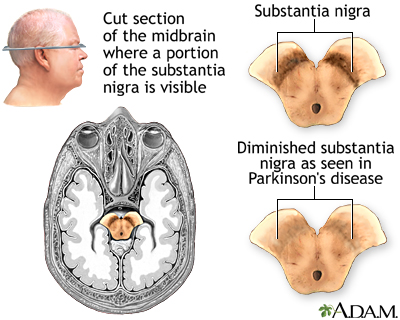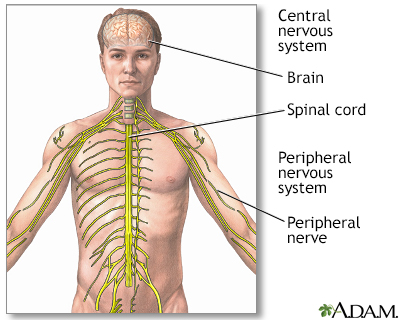Health Library
Parkinson disease
Paralysis agitans; Shaking palsy
Parkinson disease results from certain brain cells dying. These cells help control movement and coordination. The disease leads to shaking (tremors) and trouble walking and moving.
Images


Animation

I Would Like to Learn About:
Causes
Nerve cells use a brain chemical called dopamine to help control muscle movement. With Parkinson disease, the brain cells that make dopamine slowly die. Without dopamine, the cells that control movement can't send proper messages to the muscles. This makes it hard to control the muscles. Slowly, over time, this damage gets worse. No one knows exactly why these brain cells waste away.
Parkinson disease most often develops after age 50. It is one of the most common nervous system problems in older adults.
- The disease tends to affect men more than women, although women also develop the disease. Parkinson disease sometimes runs in families.
- The disease can occur in younger adults. In such cases, it is often due to the person's genes.
- Parkinson disease is rare in children.
Symptoms
Symptoms may be mild at first. For instance, you may have a mild tremor or a slight feeling that one leg is stiff and dragging. Jaw tremor has also been an early sign of Parkinson disease. Symptoms may affect one or both sides of the body.
General symptoms may include:
- Problems with balance and walking
- Rigid or stiff muscles
- Muscle aches and pains
- Low blood pressure when you stand up
- Stooped posture
- Constipation
- Sweating and not being able to control your body temperature
- Slow blinking
- Difficulty swallowing
- Drooling
- Slowed, quieter speech and monotone voice
- No expression in your face (like you are wearing a mask)
- Unable to write clearly or handwriting is very small (micrographia)
Movement problems may include:
- Difficulty starting movement, such as starting to walk or getting out of a chair
- Difficulty continuing to move
- Slowed movements
- Loss of fine hand movements (writing may become small and difficult to read)
- Difficulty eating
Symptoms of shaking (tremors):
- Usually occur when your limbs are not moving. This is called resting tremor.
- Occur when your arm or leg is held out.
- Go away when you move.
- May be worse when you are tired, excited, or stressed.
- Can cause you to rub your finger and thumb together without meaning to (called pill-rolling tremor).
- Eventually may occur in your head, lips, tongue, and feet.
Other symptoms may include:
- Anxiety, stress, and tension
- Confusion and memory problems
- Dementia
- Depression
- Disturbed sleep
- Fainting
- Low blood pressure
- Memory loss
Exams and Tests
Your health care provider may be able to diagnose Parkinson disease based on your symptoms and a physical exam. But the symptoms can be hard to pin down, particularly in older adults. Symptoms are easier to recognize as the illness gets worse.
The examination may show:
- Difficulty starting or finishing a movement
- Jerky, stiff movements
- Muscle loss
- Shaking (tremors)
- Changes in your heart rate
- Normal muscle reflexes
Your provider may do some tests to rule out other conditions that can cause similar symptoms.
Treatment
There is no cure for Parkinson disease, but treatment can help control your symptoms.
MEDICINE
Your provider will prescribe medicines to help control your shaking and movement symptoms.
At certain times during the day, the medicine may wear off and symptoms can return. If this happens, your provider may need to change any of the following:
- Type of medicine
- Dose
- Amount of time between doses
- The way you take the medicine
You may also need to take medicines to help with:
- Mood and thinking problems
- Pain relief
- Sleep problems
- Drooling (botulinum toxin is often used)
Parkinson medicines can cause severe side effects, including:
- Confusion
- Seeing or hearing things that are not there (hallucinations)
- Nausea, vomiting, or diarrhea
- Feeling lightheaded or fainting
- Behaviors that are hard to control, such as gambling
- Delirium
Tell your provider right away if you have these side effects. Never change or stop taking any medicines without talking with your provider. Stopping some medicines for Parkinson disease may lead to a severe reaction. Work with your provider to find a treatment plan that works for you.
As the disease gets worse, symptoms such as stooped posture, frozen movements, and speech problems may not respond to the medicines.
SURGERY
Surgery may be an option for some people. Surgery does not cure Parkinson disease, but it may help ease symptoms. Types of surgery include:
- Deep brain stimulation -- This involves placing electric stimulators in areas of the brain that control movement.
- Surgery to destroy brain tissue that causes Parkinson symptoms.
- Stem cell transplant and other procedures are being studied.
LIFESTYLE
Certain lifestyle changes may help you cope with Parkinson disease:
- Stay healthy by eating nutritious foods and not smoking.
- Make changes in what you eat or drink if you have swallowing problems.
- Use speech therapy to help you adjust to changes in your swallowing and speech.
- Stay active as much as possible when you feel good. Do not overdo it when your energy is low.
- Rest as needed during the day and avoid stress.
- Use physical therapy and occupational therapy to help you stay independent and reduce the risk of falls.
- Place handrails throughout your house to help prevent falls. Place them in bathrooms and along stairways.
- Use assistive devices, when needed, to make movement easier. These devices may include special eating utensils, wheelchairs, bed lifts, shower chairs, and walkers.
- Talk to a social worker or other counseling service to help you and your family cope with the disorder. These services can also help you get outside help, such as Meals on Wheels.
Support Groups
Parkinson disease support groups can help you cope with the changes caused by the disease. Sharing with others who have common experiences can help you feel less alone.
Outlook (Prognosis)
Medicines can help most people with Parkinson disease. How well medicines relieve symptoms and for how long they relieve symptoms can be different in each person.
The disorder gets worse until a person is totally disabled, although in some people, this can take decades. Parkinson disease may lead to a decline in brain function and early death. Medicines may prolong function and independence.
Possible Complications
Parkinson disease may cause problems such as:
- Difficulty performing daily activities
- Difficulty swallowing or eating
- Disability (differs from person to person)
- Injuries from falls
- Pneumonia from breathing in saliva or from choking on food
- Side effects of medicines
When to Contact a Medical Professional
Contact your provider if:
- You have symptoms of Parkinson disease
- Symptoms get worse
- New symptoms occur
If you take medicines for Parkinson disease, tell your provider about any side effects, which may include:
- Changes in alertness, behavior, or mood
- Delusional behavior
- Dizziness
- Hallucinations
- Involuntary movements
- Loss of mental functions
- Nausea and vomiting
- Severe confusion or disorientation
Also contact your provider if the condition gets worse and home care is no longer possible.
Related Information
Walking abnormalitiesMuscle cramps
Secondary parkinsonism
Catecholamine blood test
Dementia
Eating extra calories when sick - adults
Swallowing problems
References
Armstrong MJ, Okun MS. Diagnosis and treatment of parkinson disease: a review. JAMA. 2020;323(6):548-560. PMID: 32044947 pubmed.ncbi.nlm.nih.gov/32044947/.
Fox SH, Katzenschlager R, Lim SY, et al; Movement Disorder Society Evidence-Based Medicine Committee. International Parkinson and Movement Disorder Society evidence-based medicine review: update on treatments for the motor symptoms of Parkinson's disease. Mov Disord. 2018;33(8):1248-1266. PMID: 29570866 pubmed.ncbi.nlm.nih.gov/29570866/.
Jankovic J. Parkinson disease and other movement disorders. In: Jankovic J, Mazziotta JC, Pomeroy SL, Newman NJ, eds. Bradley and Daroff's Neurology in Clinical Practice. 8th ed. Philadelphia, PA: Elsevier; 2022:chap 96.
Okun MS, Lang AE. Parkinsonism. In: Goldman L, Schafer AI, eds. Goldman-Cecil Medicine. 26th ed. Philadelphia, PA: Elsevier; 2020:chap 381.
Radder DLM, Sturkenboom IH, van Nimwegen M, et al. Physical therapy and occupational therapy in Parkinson's disease. Int J Neurosci. 2017;127(10):930-943. PMID: 28007002 pubmed.ncbi.nlm.nih.gov/28007002/.
BACK TO TOPReview Date: 1/23/2022
Reviewed By: Joseph V. Campellone, MD, Department of Neurology, Cooper Medical School at Rowan University, Camden, NJ. Review provided by VeriMed Healthcare Network. Also reviewed by David Zieve, MD, MHA, Medical Director, Brenda Conaway, Editorial Director, and the A.D.A.M. Editorial team.
 | A.D.A.M., Inc. is accredited by URAC, for Health Content Provider (www.urac.org). URAC's accreditation program is an independent audit to verify that A.D.A.M. follows rigorous standards of quality and accountability. A.D.A.M. is among the first to achieve this important distinction for online health information and services. Learn more about A.D.A.M.'s editorial policy, editorial process and privacy policy. A.D.A.M. is also a founding member of Hi-Ethics. This site complies with the HONcode standard for trustworthy health information: verify here. |
The information provided herein should not be used during any medical emergency or for the diagnosis or treatment of any medical condition. A licensed medical professional should be consulted for diagnosis and treatment of any and all medical conditions. Links to other sites are provided for information only -- they do not constitute endorsements of those other sites. © 1997- 2022 A.D.A.M., a business unit of Ebix, Inc. Any duplication or distribution of the information contained herein is strictly prohibited.
